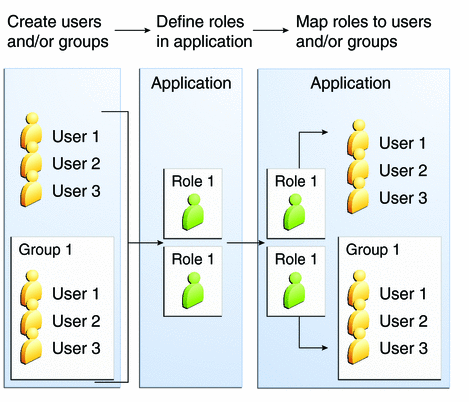Authorization
Authorization, also known as access control, is the means by which users are granted permission to access data or perform operations. After a user is authenticated, the user's level of authorization determines what operations the owner can perform. A user's authorization is based on the user's role.
Roles
A role defines which applications and what parts of each application users can access and what those users or groups can do with the applications. For example, in a personnel application, all employees might be able to see phone numbers and email addresses, but only managers have access to salary information. This application would define at least two roles: employee and manager. Only users in the manager role are allowed to view salary information.
A role is different from a group in that a role defines a function in an application, while a group is a set of users who are related in some way. For example, the personnel application specify groups such as full-time, part-time, and on-leave. Users in these groups are all employees (the employee role). In addition, each user has its own designation that defines an additional level of employment.
Roles are defined in the deployment descriptor for the application. The application developer or deployer maps roles to one or more groups in the deployment descriptor for each application. When the application is being packaged and deployed, the application specifies mappings between users, groups, and roles, as illustrated in the following figure.
Figure 11–1 Role Mapping

Java Authorization Contract for Containers
Java Authorization Contract for Containers (JACC) is the part of the Java EE specification that defines an interface for pluggable authorization providers. This enables you to set up third-party plug-in modules to perform authorization. By default, the GlassFish Server provides a simple, file-based authorization engine that complies with the JACC specification. You can also specify additional third-party JACC providers.
JACC providers use the Java Authentication and Authorization Service (JAAS) APIs. JAAS enables services to authenticate and enforce access controls upon users. JAAS implements a Java technology version of the standard Pluggable Authentication Module (PAM) framework.
JSR 196 allows you to develop plugins at different layers. You can define plugins that change the way new authentication mechanism are configured, such as, AuthConfigProvider and AuthConfigFactory. You can also define new authentication mechanisms, such as ServerAuthModule and ClientAuthModule.
- © 2010, Oracle Corporation and/or its affiliates
